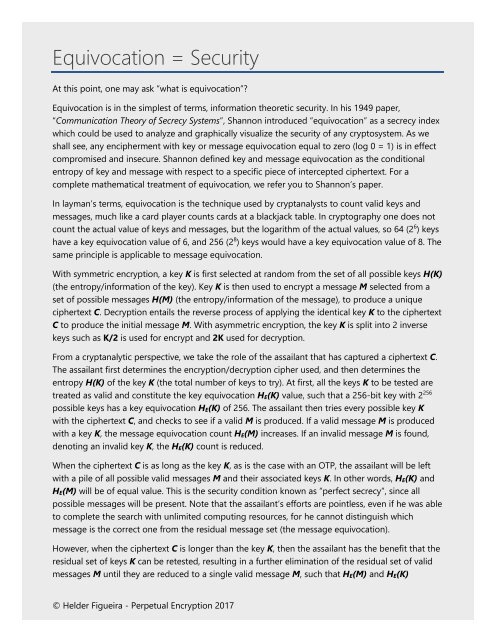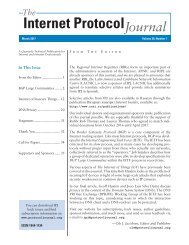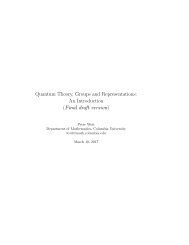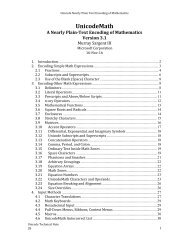The Nino Cipher
2nofXEA
2nofXEA
You also want an ePaper? Increase the reach of your titles
YUMPU automatically turns print PDFs into web optimized ePapers that Google loves.
Equivocation = Security<br />
At this point, one may ask “what is equivocation”?<br />
Equivocation is in the simplest of terms, information theoretic security. In his 1949 paper,<br />
“Communication <strong>The</strong>ory of Secrecy Systems”, Shannon introduced “equivocation” as a secrecy index<br />
which could be used to analyze and graphically visualize the security of any cryptosystem. As we<br />
shall see, any encipherment with key or message equivocation equal to zero (log 0 = 1) is in effect<br />
compromised and insecure. Shannon defined key and message equivocation as the conditional<br />
entropy of key and message with respect to a specific piece of intercepted ciphertext. For a<br />
complete mathematical treatment of equivocation, we refer you to Shannon’s paper.<br />
In layman’s terms, equivocation is the technique used by cryptanalysts to count valid keys and<br />
messages, much like a card player counts cards at a blackjack table. In cryptography one does not<br />
count the actual value of keys and messages, but the logarithm of the actual values, so 64 (2 6 ) keys<br />
have a key equivocation value of 6, and 256 (2 8 ) keys would have a key equivocation value of 8. <strong>The</strong><br />
same principle is applicable to message equivocation.<br />
With symmetric encryption, a key K is first selected at random from the set of all possible keys H(K)<br />
(the entropy/information of the key). Key K is then used to encrypt a message M selected from a<br />
set of possible messages H(M) (the entropy/information of the message), to produce a unique<br />
ciphertext C. Decryption entails the reverse process of applying the identical key K to the ciphertext<br />
C to produce the initial message M. With asymmetric encryption, the key K is split into 2 inverse<br />
keys such as K/2 is used for encrypt and 2K used for decryption.<br />
From a cryptanalytic perspective, we take the role of the assailant that has captured a ciphertext C.<br />
<strong>The</strong> assailant first determines the encryption/decryption cipher used, and then determines the<br />
entropy H(K) of the key K (the total number of keys to try). At first, all the keys K to be tested are<br />
treated as valid and constitute the key equivocation H E(K) value, such that a 256-bit key with 2 256<br />
possible keys has a key equivocation H E(K) of 256. <strong>The</strong> assailant then tries every possible key K<br />
with the ciphertext C, and checks to see if a valid M is produced. If a valid message M is produced<br />
with a key K, the message equivocation count H E(M) increases. If an invalid message M is found,<br />
denoting an invalid key K, the H E(K) count is reduced.<br />
When the ciphertext C is as long as the key K, as is the case with an OTP, the assailant will be left<br />
with a pile of all possible valid messages M and their associated keys K. In other words, H E(K) and<br />
H E(M) will be of equal value. This is the security condition known as “perfect secrecy”, since all<br />
possible messages will be present. Note that the assailant’s efforts are pointless, even if he was able<br />
to complete the search with unlimited computing resources, for he cannot distinguish which<br />
message is the correct one from the residual message set (the message equivocation).<br />
However, when the ciphertext C is longer than the key K, then the assailant has the benefit that the<br />
residual set of keys K can be retested, resulting in a further elimination of the residual set of valid<br />
messages M until they are reduced to a single valid message M, such that H E(M) and H E(K)<br />
© Helder Figueira - Perpetual Encryption 2017















